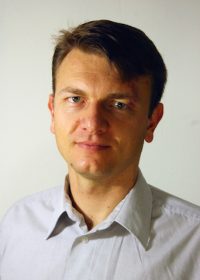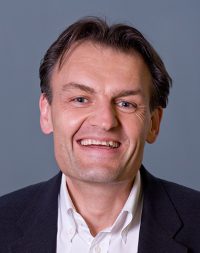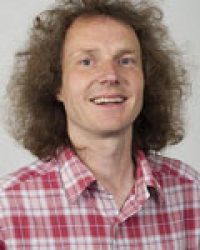Keynote Plenary Sessions
November 27th, 2023
Medium Voltage Direct Current Technologies
A large body of academic and industrial research work has been done in the field of medium voltage direct current (MVDC) power distribution networks, applicable to various applications. Despite that, commercialization is lacking. The keynote talk will address this field in a broad sense and provide an overview of various power electronics technologies, existing or needed, to enable these applications. Among these are high-power AC-DC and DC-DC converters, realized either as monolithic blocks or as solid-state transformers, as well as various protection equipment and concepts. A critical overview will be provided.

Prof. Drazen Dujic
Ecole Polytechnique Federale de Lausanne (EPFL), CH
Drazen Dujic (Senior Member, IEEE) received the Dipl.-Ing. and M.Sc. degrees in electrical engineering from the University of Novi Sad, Novi Sad, Serbia, in 2002 and 2005, respectively, and the Ph.D. degree in electrical engineering from Liverpool John Moores University, Liverpool, U.K., in 2008. From 2002 to 2006, he was a Research Assistant with the Department of Electrical Engineering, University of Novi Sad. From 2006 to 2009, he was a Research Associate with Liverpool John Moores University. From 2009 to 2013, he was with ABB Corporate Research Center, Switzerland, as a Principal Scientist, working on power electronics projects spanning the range from low-voltage/power SMPS in below kilowatt range to medium voltage high-power converters in a megawatt range. From 2010 to 2011, he was a member of a project team responsible for developing the world’s first power electronic traction transformer successfully commissioned on a locomotive. From 2013 to 2014, he was with ABB Medium Voltage Drives, Turgi, Switzerland, as a Research and Development Platform Manager, responsible for ABB’s largest IGCT-based medium-voltage drive ACS6000. He is currently with the École Polytechnique Fédérale de Lausanne (EPFL), Lausanne, Switzerland, as an Associate Professor and the Director of the Power Electronics Laboratory. He has authored or co-authored more than 200 scientific publications and has filed 20 patents. His current research interest includes the design and control of advanced high-power electronics systems for medium-voltage applications. Dr. Dujic received the First Prize Paper Award from the Electric Machines Committee of the IEEE Industrial Electronics Society, in 2007. In 2014, he received the Isao Takahashi Power Electronics Award for outstanding achievement in power electronics. In 2018, he received the EPE Outstanding ServiceAward from the European Power Electronics and Drives Association. He is an Associate Editor of IEEE Transaction on Power Electronics.
GaN/SiC Monolithic Bidirectional Switches – Drivers of a Next Wave of Power Electronics Innovations
Power Electronics is a key technology for all forms of generation and utilization of electric power in modern societies, ranging from renewable energy systems and highly diverse power supply applications including fast-charging of EVs and hyper-scale datacenters to variable frequency drives for industrial automation. The progress in the area has been driven over the past 40 years by new power semiconductor device concepts and corresponding circuit topologies, with a focus on voltage-source converter (VSC) structures and/or the application of switching elements limited to unipolar voltage-blocking capability. With reference to recently intensifying R&D activities on two-gate monolithic bi-directional switches (M-BDSs) featuring bipolar voltage blocking and bidirectional current control capability, the talk highlights the potential advantages of M-BDSs for the realization of ultra-compact non-isolated and isolated three-phase PFC rectifier systems and next generation inverter systems with low motor insulation stress. In this context, the performance gains achievable utilizing three-level T-type VSC topologies, new Solid-State-Transformer structures, and the unique features of current-source converter approaches – today solely employed in thyristor-based high-power medium-voltage motor drives – and AC/AC matrix converter concepts over state-of-the-art VSC systems are emphasized. Final considerations are on the paramount importance of advanced integration and packaging technologies for the next disruptive performance improvement of power electronics systems.

Prof. Johann W. Kolar
ETH Zurich, CH
Johann W. Kolar is a Fellow of the IEEE, an International Member of the US NAE and a Full Professor and Head of the Power Electronic Systems Laboratory at the Swiss Federal Institute of Technology (ETH) Zurich. He has proposed numerous novel converter concepts incl. the Vienna Rectifier, has spearheaded the development of x-million rpm motors, and has pioneered fully automated multi-objective power electronics design procedures. He has supervised 90 Ph.D. students to completion, has published 1000+ IEEE journal and conference papers, 4 book chapters, and has filed 200+ patents in the course of international industry research collaborations incl. 190 granted patents (44 international/WO patents, 28 US patents, 100+ patents in various European countries). He has served as IEEE PELS Distinguished Lecturer from 2012 to 2016. He has received numerous awards incl. 45+IEEE transactions and conference Prize Paper Awards, the 2016 IEEE William E. Newell Power Electronics Award, and 2 ETH Zurich Golden Owl Awards for excellence in teaching. The focus of his current research is on ultra-compact/efficient WBG converter systems, ANN-supported multi-objective design procedures, Solid-State Transformers, ultra-high speed drives, bearingless actuators, and life cycle analyses of power electronics converter systems.
November 28th, 2023
Unlocking the Potentials of Multi-Terminal HVDC Grids in Future Power Systems
High Voltage DC (HVDC) transmission is a long-standing technology with many installations around the world. Over the past few years, significant breakthroughs in the voltage-sourced converter technology along with their attractive features have made the HVDC technology even more promising in providing enhanced reliability and functionality and reducing cost and power losses. Concomitantly, significant changes in generation, transmission, and loads such as (i) integration and tapping renewable energy generation in remote areas, (ii) need for relocation or bypassing older conventional and/or nuclear power plants, (iii) increasing transmission capacity, and (iv) urbanization and the need to feed the large cities have emerged. These new trends have called for Multi-Terminal DC (MTDC) systems, which when embedded inside the AC grid, can enhance stability, reliability, and efficiency of the present power grid. The strategic importance of MVDC and HVDC grids is evidenced by the number of worldwide projects currently in their advanced planning stage, e.g., European “Supergrids” and the Baltic Sea project along with several projects in the US and China. This presentation is focused on the opportunities and challenges associated with the MTDC grids in the future power systems.

Prof. Maryam Saeedifard
Georgia Institute of Technology, US
Maryam Saeedifard received the Ph.D. degree in electrical engineering from the University of Toronto, in 2008. Since January 2014, she has been with the School of Electrical and Computer Engineering at Georgia Institute of Technology, where she is currently a professor and holds a Dean’s professorship. She is the recipient of Roger Webb’s Excellence in Mentorship Award from the School of Electrical and Computer Engineering at Georgia Tech in 2023, the 8th Nagamori Awards from Nagamori Foundation in 2022, Roger Webb’s Outstanding Mid-Career Faculty Award from the School of Electrical and Computer Engineering at Georgia Tech in 2021, U.S. Clean Energy Education and Empowerment (C3E) Technology Research & Innovation Award from the Department of Energy in 2021, First Place Prize Paper Award from the IEEE Transactions on Power Electronics in 2022 and 2021, Best Transactions Paper Award of the IEEE Transactions on Industrial Electronics in 2018 and 2016, IEEE J. David Irwin Early Career Award in 2018, U.S. National Academy of Engineering, Frontiers in Engineering in Education in 2012, U.S. National Academy of Engineering, Frontiers in Engineering in 2011, Excellence in Research Award from the Office of Vice President in Research at Purdue University in 2012 and 2011 and IEEE Richard M. Bass Outstanding Young Power Electronic Engineer Award in 2010. She is an IEEE Fellow and is currently serving as a Co-Editor-in-Chief of IEEE Trans. on Power Electronics. Her research interests include power electronics and its applications in terrestrial and mobile power systems.
Trends and Challenges for Propulsion Systems in the Electrification of Aircraft and Road Vehicles
This keynote presentation will consider the roadmaps for aircraft propulsion electrification and will draw on comparisons with other transportation electrification platforms, including cars/motorbikes, and the technological developments which are going to be needed to make these visions possible. These developments and technology challenges will include the electrical drivetrain design and the applications of motor design and power converter topology choices as well as the impact of emerging technology advances including cooling techniques, integration, system optimisation and wide-bandgap semiconductors. The future ongoing challenges for us as Power Electronics and Electrical Machines experts will also be considered.

Prof. Patrick Wheeler
University of Nottingham, UK
Prof Pat Wheeler received his BEng [Hons] degree in 1990 from the University of Bristol, UK. He received his PhD degree in Electrical Engineering for his work on Matrix Converters from the University of Bristol, UK in 1994. In 1993 he moved to the University of Nottingham and worked as a research assistant in the Department of Electrical and Electronic Engineering. In 1996 he became a Lecturer in the Power Electronics, Machines and Control Group at the University of Nottingham, UK. Since January 2008 he has been a Full Professor in the same research group. He is currently the Global Engagement Director For the Faculty of Engineering, the Head of the Power Electronics, Machines and Control Research Group and was the Director of the University of Nottingham’s Institute of Aerospace Technology. He was Head of the Department of Electrical and Electronic Engineering at the University of Nottingham from 2015 to 2018. He is a member of the IEEE PELs AdCom and is currently IEEE PELS Vice-President for Technical Operations. He has published over 850 academic publications in leading international conferences and journals.
November 29th, 2023
High power-density and high-efficiency power electronics drives for electric and hybrid electric vehicles using WBG Devices
The automotive industry is undergoing rapid development and challenges for research and development about electric vehicles. In this presentation, Prof. Sarlioglu will present the latest advancements related to electric vehicle technology with a specific interest in power electronics and drives. Most recently, silicon carbide and gallium nitride power devices are gaining attention and application in electric vehicles. These new power devices offer higher switching speed, reduced loss, higher voltage rating, and operation temperature than conventional Si devices such as IGBTs. For many benefits, integrated motor drives are also vital for combining power electronics and motors in close proximity. The efficiency of the motor drives can be increased significantly by using WBG devices. For example, in electric vehicles, 1% less loss in a power electronic drive can yield 1% less battery for the same desired range of the vehicle. Hence, topics will include WBG-based power electronics such as silicon carbide and gallium nitride and their application for voltage and current source inverters. The latest technological developments and research will be reviewed in Dr. Sarlioglu’s keynote speech.

Prof. Bulent Sarlioglu
University of Wisconsin-Madison, US
Bulent Sarlioglu is a Professor in the Electrical and Computer Engineering Department at the University of Wisconsin-Madison and the Associate Director of the Wisconsin Electric Machines and Power Electronics Consortium (WEMPEC). Bulent Sarlioglu received his Ph.D. degree from the University of Wisconsin-Madison. Sarlioglu made significant contributions to the aerospace and electric vehicle industry, graduated 17 Ph.D. students, and educated thousands of engineers via short courses. His current research goal is to increase the power density and efficiency of electric motors and power electronics using wide bandgap devices, particularly for electric vehicles and electric aviation applications. Sarlioglu has published over 200 technical papers. He holds 24 US Patents and 12 foreign patents. Some of his patents were implemented in today’s modern passenger aircraft. Sarlioglu received the IEEE PES Cyril Veniott Award in 2021 and is a Fellow of the Institute of Electrical and Electronics Engineers (IEEE) and a fellow of the National Academy of Inventors.
Impact of Power Electronics Use on Resource Efficiency of Energy Supply
Power electronics does not only penetrate many individual applications, but also lead to transformations in the infrastructure of society. This also means a change in the use of resources compared to previous developments. The replacement of fossil energy forms by renewable energy types and the increasing use of electrical energy have great potential in their dissemination. Particularly in the fields of drive technology, the generation and distribution of electrical energy, and electromobility, the changes have already begun and will continue. As a result, materials for which there was previously only a relatively small demand will also come into mass use. At the same time, the use of resources in drive technology and electromobility applications and in storage technology varies. Due to the large demand for materials, the preparation of an efficient circular economy is necessary. This requires principles already at the design stage that simplify repair, enable materials to be reused and prepare equipment and systems for long service lifes. The resulting areas of tension are outlined and conclusions drawn for further development.

Prof. Peter Zacharias
University of Kassel, Germany
Peter Zacharias (IEEE) received his PhD in electrical engineering from Otto von Guericke University Magdeburg, Germany, in 1981. Until 1990, he worked at the University of Magdeburg as a lecturer in power electronics, developing current sources for electrical discharge machining (EDM) and various high-power lasers. 1990 to 1995 he worked at Lambda Physik Göttingen on the development of excimer lasers for ophthalmology and photolithography. 1995-2001 he was employed by the Institute for Solar Energy Technology (ISET), Kassel, and was head of division for power electronic systems in photovoltaics and small wind turbines. In 2001 he moved on to eupec / Infineon in Warstein with responsibility for power electronic assemblies. Main application areas of these assemblies were wind turbines, large solar converters and industrial drives of higher power. Since 2005 he has been a full professor for electrical power systems at the University of Kassel. His focus is on power electronic converters for public power supply and industrial applications. Since January 2009 he is spokesman of the ‘Competence Center for Decentralized Electrical Power Systems’ (KDEE) of the university of Kassel. His special interest is on inductive components in power electronic converters. He has written numerous publications on this subject as well as a book specifically on inductive components. Peter Zacharias was awarded the Outstanding Achievement Award at EPE 2022.
